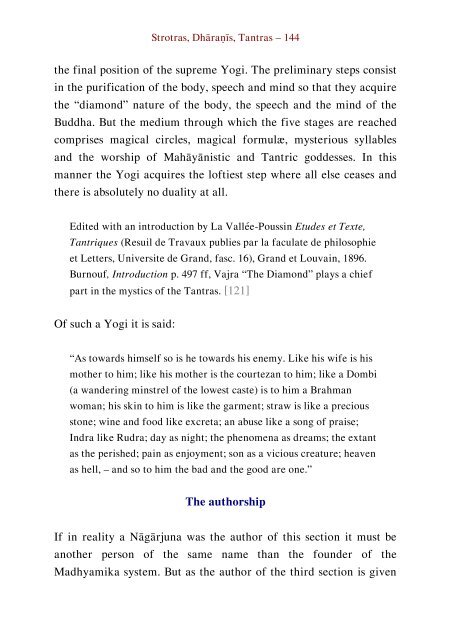Literary History of Sanskrit Buddhism
A study by J. K. Nariman of Sanskrit Buddhism from the Early Buddhist Tradition up to the Mahayana texts proper.
A study by J. K. Nariman of Sanskrit Buddhism from the Early Buddhist Tradition up to the Mahayana texts proper.
Create successful ePaper yourself
Turn your PDF publications into a flip-book with our unique Google optimized e-Paper software.
Strotras, Dhāraṇīs, Tantras – 144<br />
the final position <strong>of</strong> the supreme Yogi. The preliminary steps consist<br />
in the purification <strong>of</strong> the body, speech and mind so that they acquire<br />
the “diamond” nature <strong>of</strong> the body, the speech and the mind <strong>of</strong> the<br />
Buddha. But the medium through which the five stages are reached<br />
comprises magical circles, magical formulæ, mysterious syllables<br />
and the worship <strong>of</strong> Mahāyānistic and Tantric goddesses. In this<br />
manner the Yogi acquires the l<strong>of</strong>tiest step where all else ceases and<br />
there is absolutely no duality at all.<br />
Edited with an introduction by La Vallée-Poussin Etudes et Texte,<br />
Tantriques (Resuil de Travaux publies par la faculate de philosophie<br />
et Letters, Universite de Grand, fasc. 16), Grand et Louvain, 1896.<br />
Burnouf, Introduction p. 497 ff, Vajra “The Diamond” plays a chief<br />
part in the mystics <strong>of</strong> the Tantras. [121]<br />
Of such a Yogi it is said:<br />
“As towards himself so is he towards his enemy. Like his wife is his<br />
mother to him; like his mother is the courtezan to him; like a Dombi<br />
(a wandering minstrel <strong>of</strong> the lowest caste) is to him a Brahman<br />
woman; his skin to him is like the garment; straw is like a precious<br />
stone; wine and food like excreta; an abuse like a song <strong>of</strong> praise;<br />
Indra like Rudra; day as night; the phenomena as dreams; the extant<br />
as the perished; pain as enjoyment; son as a vicious creature; heaven<br />
as hell, – and so to him the bad and the good are one.”<br />
The authorship<br />
If in reality a Nāgārjuna was the author <strong>of</strong> this section it must be<br />
another person <strong>of</strong> the same name than the founder <strong>of</strong> the<br />
Madhyamika system. But as the author <strong>of</strong> the third section is given


















